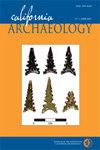Mark Alan Giambastiani (1966-2020)
IF 0.7
0 ARCHAEOLOGY
引用次数: 0
Abstract
California and Great Basin archaeology lost one of its best people with the passing of Mark Giambastiani on July 15, 2020 (Figures 1 and 2). Choice of the word “people” is deliberate, for Mark was far more than a researcher or academic; a father, mentor, musician, comedian, colleague, and most of all friend to all those who crossed his path during a much too short life. Known to many as Gumby (Gumboots to his Australian compatriots), his nearly 35-year professional career saw him employed by many of the top cultural resource management (CRM) organizations in the west, including Far Western Anthropological Research Group, Archaeological Research Center (ARC) at CSU Sacramento (CSUS), Albion Environmental, ASM Affiliates, and G2 Archaeology. He was destined to contribute much to each firm during these stops, directing scores of major projects, expanding the reach of their contract potential, and offering critical mentorship to new and existing staff. While perhaps best known as a lithics specialist, Mark in fact advanced scholarship on numerous topics and in many geographic contexts. His many collaborations with Tribal communities were especially noteworthy and deeply rooted. Mark grew up in San Rafael, Marin County, which surely had a strong influence on his life. Surrounded by magnificent landscapes and unlimited cultural opportunities, he quickly formed an attachment to the outdoors and a proclivity for hiking and camping. His family purchased a rustic beach house on Salmon Creek, just north of Bodega Bay, where they spent many weekends during the early years. Mark also developed an early affinity for sports, building lifelong ties to professional teams in the Bay Area and a special interest in playing the then unfashionable game of soccer. Although he rooted for the 49ers and Warriors, it was the Giants that received most of his attention, ever a fan of baseball. As for soccer, Mark carried the passion with him from Marin to Davis and ultimately to his last haunts in Reno, Nevada. He was playing in a recreational league nearly every weekend until the time of his passing. Music also became an essential part of Mark’s life, both listening to the new sounds and becoming involved with making them. He played in several shortlived bands in his high school years, but it was after getting to Davis that he joined the Grundybergs and made a connection that spanned the rest of his life. Playing bass guitar and covering harmony vocals, the band released the record “Outside the Boxcars” in 1990. Perhaps best characterized as folk/ rock, the Grundybergs played a range of venues in Davis, Sacramento, Berkeley, and even Santa Cruz in those initial years. Many of us lucky enough to have马克·艾伦·詹巴斯蒂亚尼(1966-2020)
2020年7月15日,Mark Giambastiani去世,加州和大盆地考古学失去了一位最优秀的人(图1和2)。选择“人”这个词是深思熟虑的,因为Mark远不止是一个研究人员或学者;他是父亲、导师、音乐家、喜剧演员、同事,最重要的是,在他短暂的一生中,他是所有遇到他的人的朋友。在近35年的职业生涯中,他被许多西方顶级文化资源管理(CRM)组织聘用,包括远西部人类学研究小组、科罗拉多州立大学萨克拉门托考古研究中心(CSUS)、阿尔比恩环境、ASM分支机构和G2考古。在这些停留期间,他注定要为每家公司做出很大贡献,指导了数十个重大项目,扩大了他们的合同潜力,并为新老员工提供了重要的指导。虽然马克最为人所知的身份可能是石器专家,但事实上,他在许多主题和许多地理背景下都有很高的学术成就。他与部落社区的许多合作尤其值得注意和深入人心。马克在马林县的圣拉斐尔长大,这对他的一生影响深远。周围是壮丽的风景和无限的文化机会,他很快就喜欢上了户外活动,喜欢徒步旅行和露营。他的家人在博德加湾(Bodega Bay)北部的鲑鱼溪(Salmon Creek)买了一栋质朴的海滨别墅,他们早年在那里度过了许多周末。马克还很早就对体育产生了好感,与旧金山湾区的职业球队建立了终生的联系,并对当时不流行的足球运动特别感兴趣。虽然他支持49人队和勇士队,但最吸引他的是巨人队,他一直是棒球迷。至于足球,马克把他的激情从马林带到戴维斯,最后带到了内华达州里诺。在他去世之前,他几乎每个周末都参加一个休闲联赛。音乐也成为了马克生活中不可或缺的一部分,他倾听新的声音,并参与制作它们。高中时,他在几个短暂的乐队中演奏过,但在进入戴维斯大学后,他加入了格兰迪堡,并建立了一个贯穿他余生的联系。乐队演奏贝斯吉他和和声,于1990年发行了专辑《Outside the Boxcars》。也许最具特色的是民谣/摇滚,在最初的几年里,Grundybergs在戴维斯,萨克拉门托,伯克利甚至圣克鲁斯的一系列场所演出。我们很多人都很幸运
本文章由计算机程序翻译,如有差异,请以英文原文为准。
求助全文
约1分钟内获得全文
求助全文

 求助内容:
求助内容: 应助结果提醒方式:
应助结果提醒方式:


